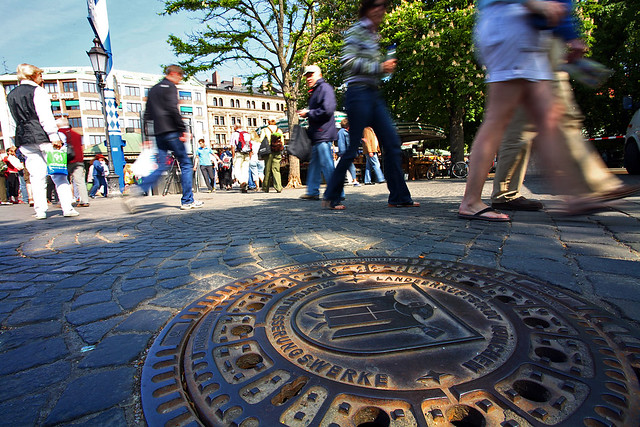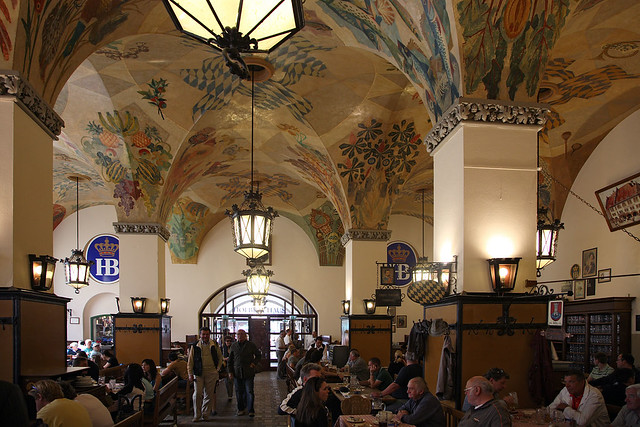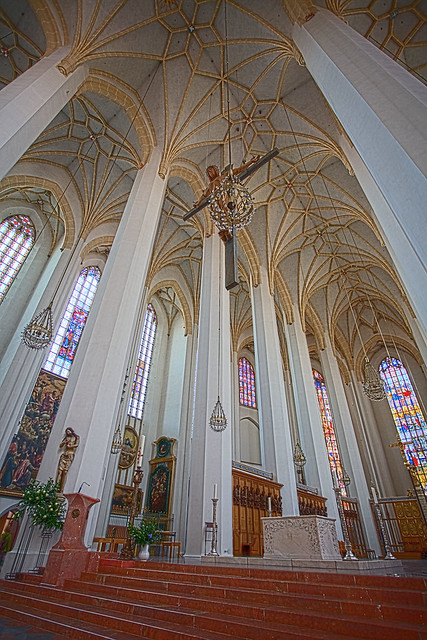
Grim Reaper sculpture inside Asamkirche
[ < < previous | index | next >> ]
We rose at 07:00 and prepared for breakfast. Michelle needed a hairdryer after her shower and we had to ask to borrow one at reception. I said, "Kanne ich bitte ein hairdryer haben?" which was good enough to get the message across to the young woman there. I then asked, "Was weißt 'hairdryer' auf Deutsch?" and she replied, "Föhn." Which is also, according to the Lonely Planet the name of the wind that blows statically charged air north from the Alps, causing a high pressure cell to sit over Munich. Apparently one dries one's hair with the south wind.
The Föhn was blowing well today, as we learnt as soon as we stepped outside, and it kept up all day, keeping things a touch on the chilly side despite the clear blue sky.
Breakfast was not up to the standards set so far, with no hot food at all, yoghurt in individual tubs, and no attempt at a fruit salad at all. They did however have two home-made "jams" that looked more like just pure blended fruit than anything with pectin in it, being totally opaque. There was a mixed berry and a strawberry. I made do with muesli, yoghurt, and some tinned peach slices, then tried the mixed berry jam on some heavy full-grain bread - delicious. I also had a cheese, tomato, and cucumber on bread, then another round of muesli to finish off the tub of yoghurt.
We left the hotel around 09:00 and walked half a block before turning around to get Michelle's jacket, since it was cold and a bit windy. I asked the woman at reception - who said, "Too cold?" as soon as we walked back in - if it would warm up later. She said definitely yes, around 25°C by the afternoon. Thus informed, I elected to shiver a little now and not have to carry my jacket around the rest of the day.
Thus armed, we set out again, planning to tackle Munich in one day by following the Lonely Planet's suggested walking tour itinerary. First up we headed to the closest point in the tour loop, at Karlsplatz, where the Lonely Planet said was an enormous landmark modern fountain. We saw no fountain as we approached, and it wasn't until we were on top of it that we realised the three large shiny metal studs in the middle of the paved circle ringed with stone blocks was the fountain, just not switched on. We walked under the medieval Karlstor gate and into the enormous pedestrian mall of Neuhauserstraße. Being before 10:00, none of the shops were open yet, and delivery trucks were running back and forth over the place like rabbits.
 Grim Reaper sculpture inside Asamkirche |
We turned south down Damenstiftstraße to the Damenstiftskirche, then to another church further along on Kreuzstraße just before we reached the 14th century Sendlinger Tor gate, where we turned up Sendlingerstraße. A short way along was the Asamkirche, which was a stunning baroque wonder inside, with gold and filigree everywhere. Amazing! As I was waiting outside for Michelle to return from looking at a shop across the road, an old Italian couple carrying a guidebook approached and stopped at the relatively unassuming exterior of the church. They looked puzzled and wandered into the neighbouring Asamhaus, which was if anything more ornately decorated on the outside than the church itself, with multiple statues and other items around the doorway. But Asamhaus is a residential property and there was nothing for them to see in there but mailboxes and bicycle parking. I assembled an Italian sentence in my head slowly: "La vista in la chiesa è bella," intending to point them at the right door. But by the time I'd recalled the words through the haze of German in my head, they were headed there anyway.
 Viktualienmarkt |
We continued up Sendlingerstraße to Rosental, where we turned south-east to find the Viktualienmarkt, a large open-air produce market which teemed with activity and boasted hundreds of stalls selling fruit and vegetables, spices, cheeses, bread, meats, fish, honey, jams, hot food (mostly sausages of various types), wines, beers, and a few handicrafts. In the centre of all this bustle was a tall blue and white striped maypole, no doubt to be the centre of tomorrow's May Day celebrations. Michelle bought a souvenir hessian bag for €2 and we wandered aimlessly in the vicinity of the maypole for a while before noticing that a film crew were filming a guy with a jacket slung over his shoulder as he walked and talked his TV audience through the Viktualienmarkt with Michelle walking along right next to him for several paces. As we beat a discreet retreat to another part of the market, we noticed the crew filming another take, presumably after the director had said, "There was a tourist walking right next to you for that entire take!"
 People in the Viktualienmarkt |
We bought some dates and cashews at two different stalls, then found a cheese seller who sliced us four pieces of Swiss cheese after we inquired. The word for "slice" wasn't in my phrasebook, so I asked the woman who served us how you say "slice" in Deutsch, and she said something that I can't recall now. Equipped with cheese, we sought out bread rolls, and bought a couple each of Kerni and 5-Korn-Semmel rolls.
 Sausages in the Viktualienmarkt |
We found a place to stand (there seemed to be no seats anywhere in Germany that are not attached to cafes and restaurants) next to the Heiliggeistkirche and ate one of our bread rolls with cheese each. While eating, we noticed a nearby sausage stall doing great business with the rostbratwurst in a roll, so I decided to get one of those too, while Michelle grabbed a take-away coffee from a nearby cafe. We consumed those standing too. After using the toilet facilities underground in the Viktualienmarkt, we left it to peek inside the Heiliggeistkirche, another Asam brothers creation with frescoes from 1727 to 1730.
 Marienplatz, from the top of St Peterskirche |
From there it was a short walk past the Altes Rathaus into Marienplatz. Wowee, talk about busy! There are some places that can be considered "crossroads of the world" - places where you can imagine that if you stand there for long enough you can see anyone go by: Times Square in New York City, the Spanish Steps in Rome, Piccadilly Circus, St Marks Square - well, Marienplatz in Munich is one of those. People were scurrying every which way like ants at a picnic. Standing still in the middle of the whirl of people was dangerous as you would perpetually be in someone's way. And around all this was the contrast of sparkling glass and steel shops on one side and the ancient black monumental stonework of the Neues Rathaus on the other ("New" in that it was built from 1867 as opposed to the Altes Rathaus' 1474). Michelle browsed the shops for a while, while I took my chances in the platz and photographed various things in the area. Some roadies were setting up a huge stage in the middle of the square, presumably for concerts tomorrow, and the main tower of the Rathaus was swathed in scaffolding for restoration work, but the scene was still highly impressive. The Mariensäule column and statues and the Fischbrunnen fountain added to the scenic delights.
 Mariensäule and the twin towers of the Frauenkirche |
After reuniting with Michelle, I showed her what I'd discovered inside the Rathaus courtyard - a veritable treasure trove of elaborate stone architecture heavily laden with gargoyles, including one of a jaunty devil with horns. We crossed Marienplatz to St Peterskirche for more spectacular church interiors. Outside again, we looked into the climb up fourteen storeys to the tower for views from 92 metres above the city. Michelle checked the narrow stone staircase from ground level and decided not to go up. I braved it and bought a ticket, then climbed the stairs all the way to the top, pausing at several of the landings, which were the only parts wide enough to allow other people to come back down. At the top, the viewing platform was a rectangular circuit around the tower, so narrow that it was literally a squeeze to get past anyone, so my progress around it was considerably slower than ideal. I took several panoramic shots of the city far below, then made my way back down, the total trip taking well over half an hour.
 Hofbräuhaus |
We followed the tour north-east to the Hofbräuhaus, most famous of all beer halls, which was doing great business and had several tourists wandering around inside taking photos, so I unashamedly joined them for a while. Retreating, we passed through the Alter Hof before reaching Max-Joseph-Platz, which had expansive views of the Nationaltheater and the south wall of the Residenz.
 Lion statue in the Feldherrnhalle |
We walked north along Residenzstraße and poked our noses into some of the courtyards within the Residenz, noting that the architecture facing the courtyards was grander and more palace-like than the exterior facades, with ornately painted artificial columns and so on. We reached Odeonsplatz and the seriously chunky Feldherrnhalle monument, consisting of wide steps flanked by giant lion statues, leading up to a platform containing an enormous bronze statue of various German military leaders. It was very photogenic, and one guy with a Nikon and a gear backpack was clambering all over it the entire time we were there.
 Cupola of Theatinerkirche |
Next to it is the Theatinerkirche, a gaudy yellow building on the outside, but yet another stunningly decorated church inside. Walking south again down Theatinerstraße led us to the side entrance of the Frauenkirche, Munich's main cathedral. Big signs on the red brick exterior warned to keep away from the walls during storms and snow, presumably because great clods of snow would slide off the roof and bury passers-by. The inside was light and airy, in contrast to the heavy exterior, the soaring white columns supporting a graceful roof overhead. The main decorations were panels of stained glass, tall and narrow (well, several metres wide, but tens of metres high, giving them a ribbon-like aspect ratio). The glass looked quite modern with slightly geometrical illustrations in the lower portions fading to geometric abstraction in the upper parts in matching colours, each window having a different dominant colour theme. I snapped some HDR sequences before being told off by a guy for having a tripod, so quickly packed it away.
 Theatinerstraße |
Leaving, we passed photos of the church from the 1800s, showing a much more ornate, baroque, and darker interior, before it was all but destroyed in the war. The present structure is therefore mostly rebuilt since then, and the interior restoration is pretty much all new. We left via the main doors to the west, turning around to face the front of the church, where the two distinctive onion domes of copper loomed way overhead on giant red brick towers, each bearing a clock (exactly on time, of course), and forming the best known architectural symbol of Munich.
 Frauenkirche interior |
From the Frauenkirche, we returned to the pedestrian shopping mall of Neuhaustraße and strolled back towards our hotel, dawdling along the way to absorb more of the city. We stopped into the Michaelskirche to have a look-see, finding its best feature to be a life-sized angel statue standing facing the altar at the back and tending a large holy water basin. Another discovery back on the mall near the Karlstor was a group of gabled roof peaks surmounted by copper sculptures of age-of-sail ships flanking one of a personification of a zephyr or something - it was a little hard to tell from ground level, four storeys below.
We returned to our hotel to consult the Lonely Planet (we'd left it there in favour of a significantly lighter folding map) on the location of the "best vegetarian restaurant in Munich", that Michelle wanted to try for dinner. We discovered it was the place we'd noticed down a side street as we walked up Sendlingerstraße earlier in the day. Thankfully it was only a few blocks away and we returned via a shorter route to the Prinz Myshkin, an upmarket but very nicely appointed place on Hackenstraße.
 Dinner at Prinz Myshkin |
The menu was large and Michelle asked for one in English, so we could read through it all. We ordered soups - rasam, a lentil and tomato with curry spices for Michelle, and pumpkin for me - and a basket of bread, which was very dark but soft and crusty. All delicious. Then Michelle had a quiche slice, while I had soy medallions in a mushroom sauce with spätzle. The quiche came with a large blob of cream cheese blended with herbs on the side. Again, all very good. Michelle had apfelschorle to drink, while I took the plunge and tried an alcohol-free weißbier, which was very mild and quite yummy. Despite several delicious looking cakes, including a delightful looking orange non-baked cheesecake, a baked cheesecake with what looked like a berry filling, and a rich, dense chocolate cake, we were too full for dessert. But the preponderance of cakes prompted the thought that there should be a standard dessert dish that consists of a slice each of chocolate cake and cheesecake, since so often the choice of dessert comes down to picking between those two options - the sensible thing would be to have some of each. I hereby christen a dessert dish consisting of a slice of chocolate cake and a slice of cheesecake a "Döppelganger".
After dinner, we walked home again, though I couldn't resist the call of a single scoop of orange gelato from a stand we walked past.
[ < < previous | index | next >> ]